Car-Free City Impact Analysis: Tourism, Environment, and Society
VerifiedAdded on 2023/06/17
|12
|2635
|56
Report
AI Summary
This report explores the concept of car-free cities, which prioritize cycling, walking, and public transport over private vehicles, and analyzes their multifaceted impacts on the tourism, hospitality, and event industries, the environment, and society. The analysis reveals that car-free cities can attract tourists seeking unique experiences, generate employment in the hospitality sector, and promote environmental sustainability by reducing carbon emissions and conserving natural resources. Socially, these cities encourage physical activity, foster community relationships, and improve public health. The report also addresses the challenges of transitioning to car-free urban environments, such as changing ingrained transportation habits and the need for robust public transport infrastructure. Recommendations are provided for stakeholders, including governments and tourism organizations, to maximize the benefits of car-free initiatives through policy implementation, public awareness campaigns, and investment in sustainable transportation options.

PROFESSIONAL SKILLS
1
1
Paraphrase This Document
Need a fresh take? Get an instant paraphrase of this document with our AI Paraphraser

EXECUTIVE SUMMARY
Car free city is new concept that focuses on making less use of vehicles to travel rather
than that makes use of cycle, walking and public transport for travelling. It has both positive and
negative impact on environment, society and tourism and hospitality industry. Therefore the
report has highlighted key information related to impact of car free city on the tourism sector,
environment and overall society. Finally, it included suggestion that could be used by
stakeholders to get maximum benefits of car free city.
2
Car free city is new concept that focuses on making less use of vehicles to travel rather
than that makes use of cycle, walking and public transport for travelling. It has both positive and
negative impact on environment, society and tourism and hospitality industry. Therefore the
report has highlighted key information related to impact of car free city on the tourism sector,
environment and overall society. Finally, it included suggestion that could be used by
stakeholders to get maximum benefits of car free city.
2
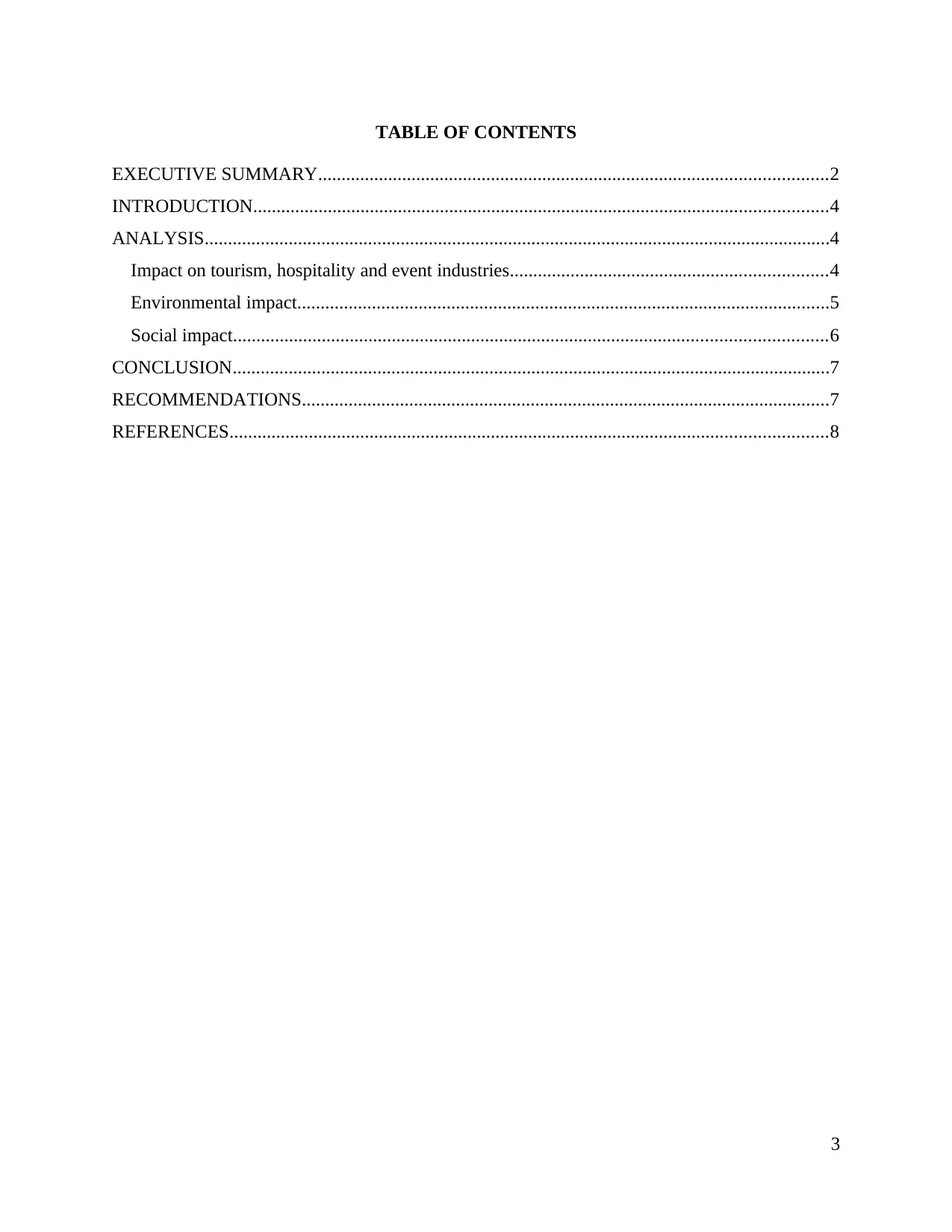
TABLE OF CONTENTS
EXECUTIVE SUMMARY.............................................................................................................2
INTRODUCTION...........................................................................................................................4
ANALYSIS......................................................................................................................................4
Impact on tourism, hospitality and event industries....................................................................4
Environmental impact..................................................................................................................5
Social impact...............................................................................................................................6
CONCLUSION................................................................................................................................7
RECOMMENDATIONS.................................................................................................................7
REFERENCES................................................................................................................................8
3
EXECUTIVE SUMMARY.............................................................................................................2
INTRODUCTION...........................................................................................................................4
ANALYSIS......................................................................................................................................4
Impact on tourism, hospitality and event industries....................................................................4
Environmental impact..................................................................................................................5
Social impact...............................................................................................................................6
CONCLUSION................................................................................................................................7
RECOMMENDATIONS.................................................................................................................7
REFERENCES................................................................................................................................8
3
⊘ This is a preview!⊘
Do you want full access?
Subscribe today to unlock all pages.

Trusted by 1+ million students worldwide
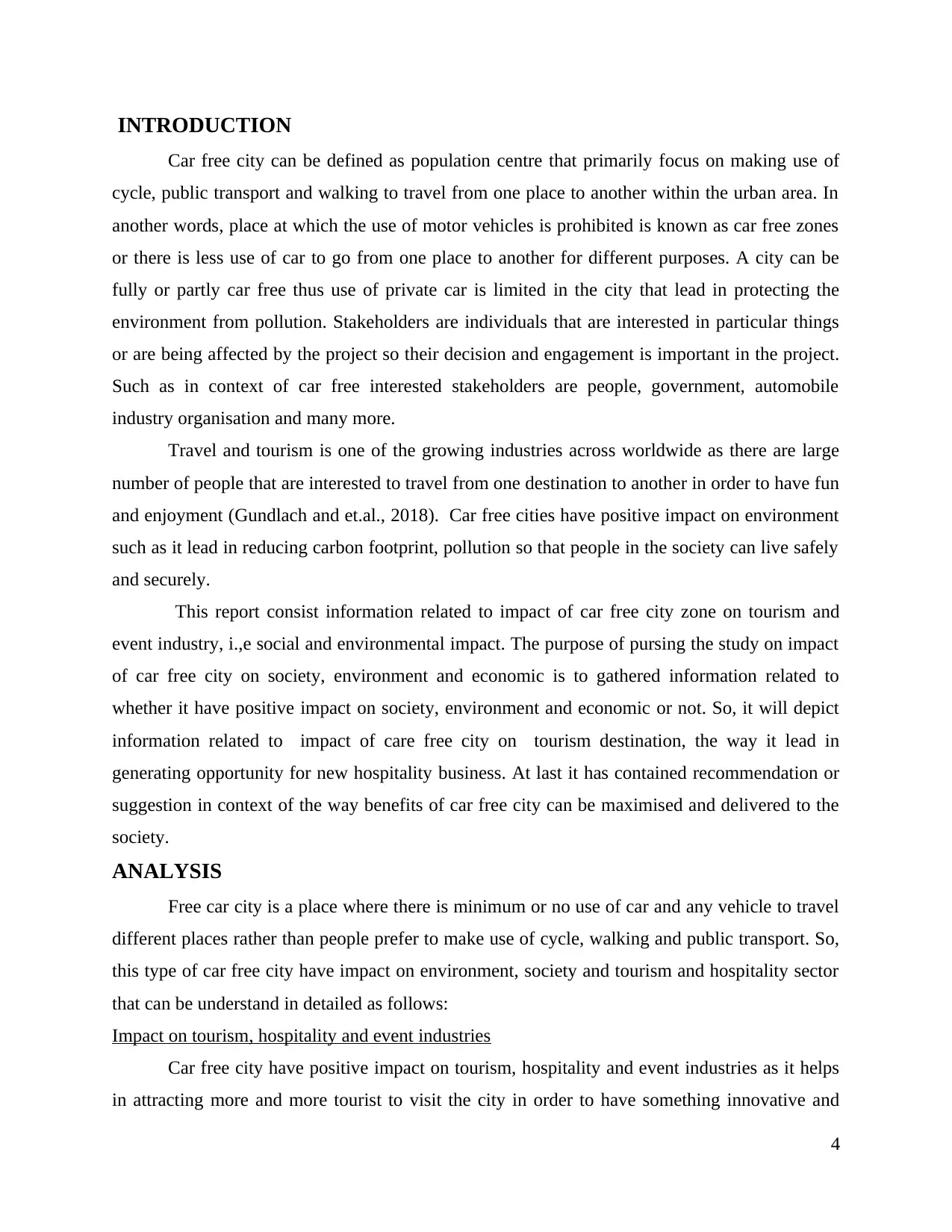
INTRODUCTION
Car free city can be defined as population centre that primarily focus on making use of
cycle, public transport and walking to travel from one place to another within the urban area. In
another words, place at which the use of motor vehicles is prohibited is known as car free zones
or there is less use of car to go from one place to another for different purposes. A city can be
fully or partly car free thus use of private car is limited in the city that lead in protecting the
environment from pollution. Stakeholders are individuals that are interested in particular things
or are being affected by the project so their decision and engagement is important in the project.
Such as in context of car free interested stakeholders are people, government, automobile
industry organisation and many more.
Travel and tourism is one of the growing industries across worldwide as there are large
number of people that are interested to travel from one destination to another in order to have fun
and enjoyment (Gundlach and et.al., 2018). Car free cities have positive impact on environment
such as it lead in reducing carbon footprint, pollution so that people in the society can live safely
and securely.
This report consist information related to impact of car free city zone on tourism and
event industry, i.,e social and environmental impact. The purpose of pursing the study on impact
of car free city on society, environment and economic is to gathered information related to
whether it have positive impact on society, environment and economic or not. So, it will depict
information related to impact of care free city on tourism destination, the way it lead in
generating opportunity for new hospitality business. At last it has contained recommendation or
suggestion in context of the way benefits of car free city can be maximised and delivered to the
society.
ANALYSIS
Free car city is a place where there is minimum or no use of car and any vehicle to travel
different places rather than people prefer to make use of cycle, walking and public transport. So,
this type of car free city have impact on environment, society and tourism and hospitality sector
that can be understand in detailed as follows:
Impact on tourism, hospitality and event industries
Car free city have positive impact on tourism, hospitality and event industries as it helps
in attracting more and more tourist to visit the city in order to have something innovative and
4
Car free city can be defined as population centre that primarily focus on making use of
cycle, public transport and walking to travel from one place to another within the urban area. In
another words, place at which the use of motor vehicles is prohibited is known as car free zones
or there is less use of car to go from one place to another for different purposes. A city can be
fully or partly car free thus use of private car is limited in the city that lead in protecting the
environment from pollution. Stakeholders are individuals that are interested in particular things
or are being affected by the project so their decision and engagement is important in the project.
Such as in context of car free interested stakeholders are people, government, automobile
industry organisation and many more.
Travel and tourism is one of the growing industries across worldwide as there are large
number of people that are interested to travel from one destination to another in order to have fun
and enjoyment (Gundlach and et.al., 2018). Car free cities have positive impact on environment
such as it lead in reducing carbon footprint, pollution so that people in the society can live safely
and securely.
This report consist information related to impact of car free city zone on tourism and
event industry, i.,e social and environmental impact. The purpose of pursing the study on impact
of car free city on society, environment and economic is to gathered information related to
whether it have positive impact on society, environment and economic or not. So, it will depict
information related to impact of care free city on tourism destination, the way it lead in
generating opportunity for new hospitality business. At last it has contained recommendation or
suggestion in context of the way benefits of car free city can be maximised and delivered to the
society.
ANALYSIS
Free car city is a place where there is minimum or no use of car and any vehicle to travel
different places rather than people prefer to make use of cycle, walking and public transport. So,
this type of car free city have impact on environment, society and tourism and hospitality sector
that can be understand in detailed as follows:
Impact on tourism, hospitality and event industries
Car free city have positive impact on tourism, hospitality and event industries as it helps
in attracting more and more tourist to visit the city in order to have something innovative and
4
Paraphrase This Document
Need a fresh take? Get an instant paraphrase of this document with our AI Paraphraser

differentiate services (Brown, 2017). They can travel across the city or visit different place while
walking or making use of cycle that contribute in saving overall cost of travel for them and they
can more closely enjoy each and every movement. It helps in generating lot of employment
opportunity in tourism, hospitality sector as with increase in number of tourist the number of
people increased to delivered services to customers. Thus it results in increasing employment
opportunity for people in tourism sector.
Furthermore, in recent scenario, most of the tourist are aware of threat or lack of
availability of natural resources in society so they wants to part of country that take step to
protect and preserve natural resources and environment. Therefore, the city by promoting car
free practice is able to save natural resource such as petrol that are utilised in vehicle to go from
one place to another for different purposes. In order to make car free society, there are various
steps that has been taken by organisation operating in tourism sector such as make people aware
about the impact of car free city on different aspects, the way it can contribute in reducing
environment pollution and many more (Wylie, 2019). At the same time, companies have trained
and guide their employees about what is car free city and the way it can be used to delivered
services to tourist that have come from different places to enjoy their leisure time.
It acts as an opportunity for new business in hospitality sector as there are many
businesses through offer cycle to tourist to ride the city and enjoy each and every place is able to
earn high profit margin. Car free is new concept so it has provided opportunity to company to
make use of the same in order to attract and retained customers for its overall benefits. It has
benefited both companies as well as travellers as their overall cost of travel is reduce, at the same
time organisation are able to enjoy more profit margin. So, it leads in development of more
transportation infrastructure thereby lead in overall growth and development of tourism and
hospitality sector.
Environmental impact
The concept of car free city has positive impact on environment as well as such as it lead
in reduction in emission of greenhouse gases. At the same time contribute in reducing the noise
level in the city as less number of vehicles is being used for travelling. Such as, it has been
estimated that after decrease use of car by people has lead in fell of nitrogen oxide by 38% and
carbon dioxide by 14.2% in the city centre. In addition to this, car pollution is main reason for
global warming in the environment as car and truck emit lot of carbon dioxide and other
5
walking or making use of cycle that contribute in saving overall cost of travel for them and they
can more closely enjoy each and every movement. It helps in generating lot of employment
opportunity in tourism, hospitality sector as with increase in number of tourist the number of
people increased to delivered services to customers. Thus it results in increasing employment
opportunity for people in tourism sector.
Furthermore, in recent scenario, most of the tourist are aware of threat or lack of
availability of natural resources in society so they wants to part of country that take step to
protect and preserve natural resources and environment. Therefore, the city by promoting car
free practice is able to save natural resource such as petrol that are utilised in vehicle to go from
one place to another for different purposes. In order to make car free society, there are various
steps that has been taken by organisation operating in tourism sector such as make people aware
about the impact of car free city on different aspects, the way it can contribute in reducing
environment pollution and many more (Wylie, 2019). At the same time, companies have trained
and guide their employees about what is car free city and the way it can be used to delivered
services to tourist that have come from different places to enjoy their leisure time.
It acts as an opportunity for new business in hospitality sector as there are many
businesses through offer cycle to tourist to ride the city and enjoy each and every place is able to
earn high profit margin. Car free is new concept so it has provided opportunity to company to
make use of the same in order to attract and retained customers for its overall benefits. It has
benefited both companies as well as travellers as their overall cost of travel is reduce, at the same
time organisation are able to enjoy more profit margin. So, it leads in development of more
transportation infrastructure thereby lead in overall growth and development of tourism and
hospitality sector.
Environmental impact
The concept of car free city has positive impact on environment as well as such as it lead
in reduction in emission of greenhouse gases. At the same time contribute in reducing the noise
level in the city as less number of vehicles is being used for travelling. Such as, it has been
estimated that after decrease use of car by people has lead in fell of nitrogen oxide by 38% and
carbon dioxide by 14.2% in the city centre. In addition to this, car pollution is main reason for
global warming in the environment as car and truck emit lot of carbon dioxide and other
5
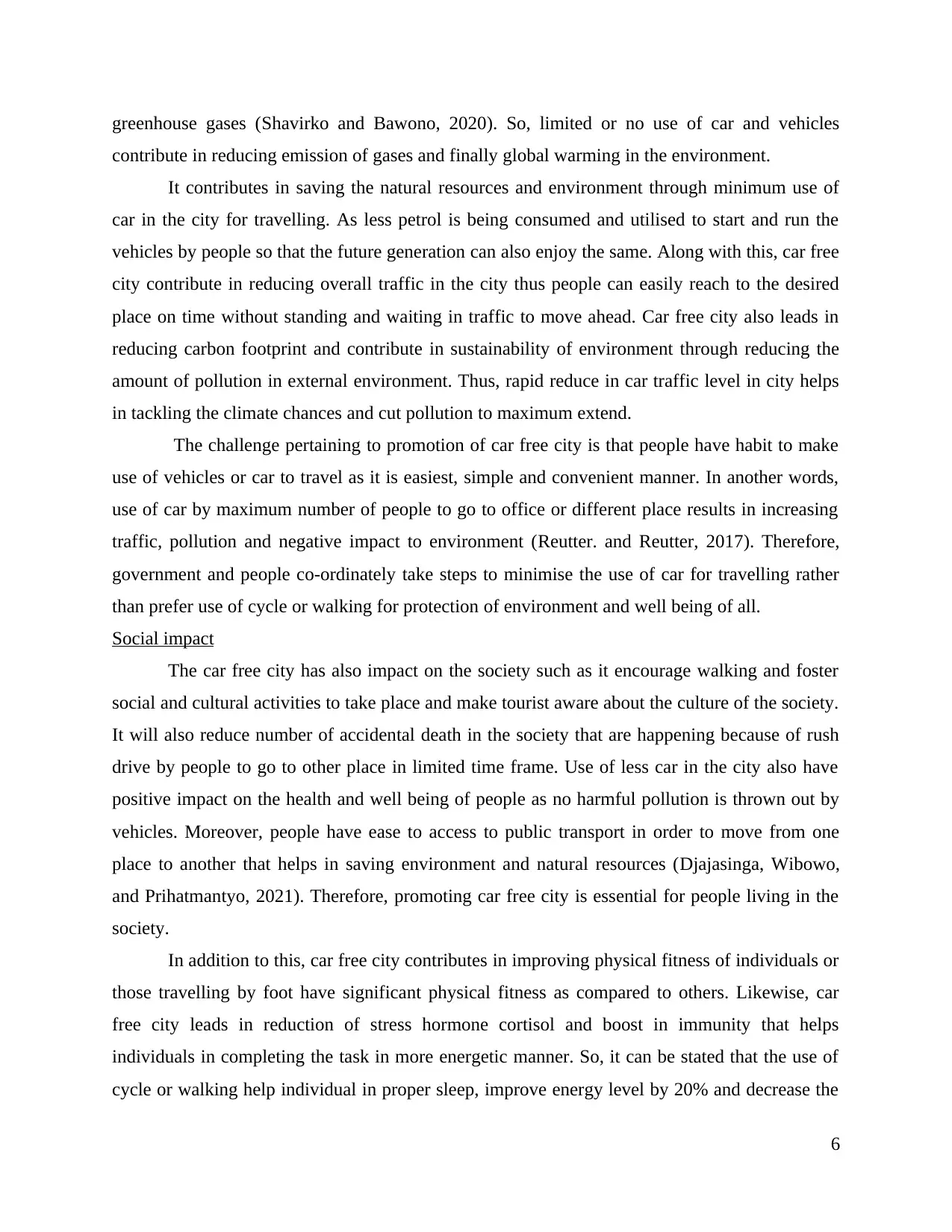
greenhouse gases (Shavirko and Bawono, 2020). So, limited or no use of car and vehicles
contribute in reducing emission of gases and finally global warming in the environment.
It contributes in saving the natural resources and environment through minimum use of
car in the city for travelling. As less petrol is being consumed and utilised to start and run the
vehicles by people so that the future generation can also enjoy the same. Along with this, car free
city contribute in reducing overall traffic in the city thus people can easily reach to the desired
place on time without standing and waiting in traffic to move ahead. Car free city also leads in
reducing carbon footprint and contribute in sustainability of environment through reducing the
amount of pollution in external environment. Thus, rapid reduce in car traffic level in city helps
in tackling the climate chances and cut pollution to maximum extend.
The challenge pertaining to promotion of car free city is that people have habit to make
use of vehicles or car to travel as it is easiest, simple and convenient manner. In another words,
use of car by maximum number of people to go to office or different place results in increasing
traffic, pollution and negative impact to environment (Reutter. and Reutter, 2017). Therefore,
government and people co-ordinately take steps to minimise the use of car for travelling rather
than prefer use of cycle or walking for protection of environment and well being of all.
Social impact
The car free city has also impact on the society such as it encourage walking and foster
social and cultural activities to take place and make tourist aware about the culture of the society.
It will also reduce number of accidental death in the society that are happening because of rush
drive by people to go to other place in limited time frame. Use of less car in the city also have
positive impact on the health and well being of people as no harmful pollution is thrown out by
vehicles. Moreover, people have ease to access to public transport in order to move from one
place to another that helps in saving environment and natural resources (Djajasinga, Wibowo,
and Prihatmantyo, 2021). Therefore, promoting car free city is essential for people living in the
society.
In addition to this, car free city contributes in improving physical fitness of individuals or
those travelling by foot have significant physical fitness as compared to others. Likewise, car
free city leads in reduction of stress hormone cortisol and boost in immunity that helps
individuals in completing the task in more energetic manner. So, it can be stated that the use of
cycle or walking help individual in proper sleep, improve energy level by 20% and decrease the
6
contribute in reducing emission of gases and finally global warming in the environment.
It contributes in saving the natural resources and environment through minimum use of
car in the city for travelling. As less petrol is being consumed and utilised to start and run the
vehicles by people so that the future generation can also enjoy the same. Along with this, car free
city contribute in reducing overall traffic in the city thus people can easily reach to the desired
place on time without standing and waiting in traffic to move ahead. Car free city also leads in
reducing carbon footprint and contribute in sustainability of environment through reducing the
amount of pollution in external environment. Thus, rapid reduce in car traffic level in city helps
in tackling the climate chances and cut pollution to maximum extend.
The challenge pertaining to promotion of car free city is that people have habit to make
use of vehicles or car to travel as it is easiest, simple and convenient manner. In another words,
use of car by maximum number of people to go to office or different place results in increasing
traffic, pollution and negative impact to environment (Reutter. and Reutter, 2017). Therefore,
government and people co-ordinately take steps to minimise the use of car for travelling rather
than prefer use of cycle or walking for protection of environment and well being of all.
Social impact
The car free city has also impact on the society such as it encourage walking and foster
social and cultural activities to take place and make tourist aware about the culture of the society.
It will also reduce number of accidental death in the society that are happening because of rush
drive by people to go to other place in limited time frame. Use of less car in the city also have
positive impact on the health and well being of people as no harmful pollution is thrown out by
vehicles. Moreover, people have ease to access to public transport in order to move from one
place to another that helps in saving environment and natural resources (Djajasinga, Wibowo,
and Prihatmantyo, 2021). Therefore, promoting car free city is essential for people living in the
society.
In addition to this, car free city contributes in improving physical fitness of individuals or
those travelling by foot have significant physical fitness as compared to others. Likewise, car
free city leads in reduction of stress hormone cortisol and boost in immunity that helps
individuals in completing the task in more energetic manner. So, it can be stated that the use of
cycle or walking help individual in proper sleep, improve energy level by 20% and decrease the
6
⊘ This is a preview!⊘
Do you want full access?
Subscribe today to unlock all pages.

Trusted by 1+ million students worldwide
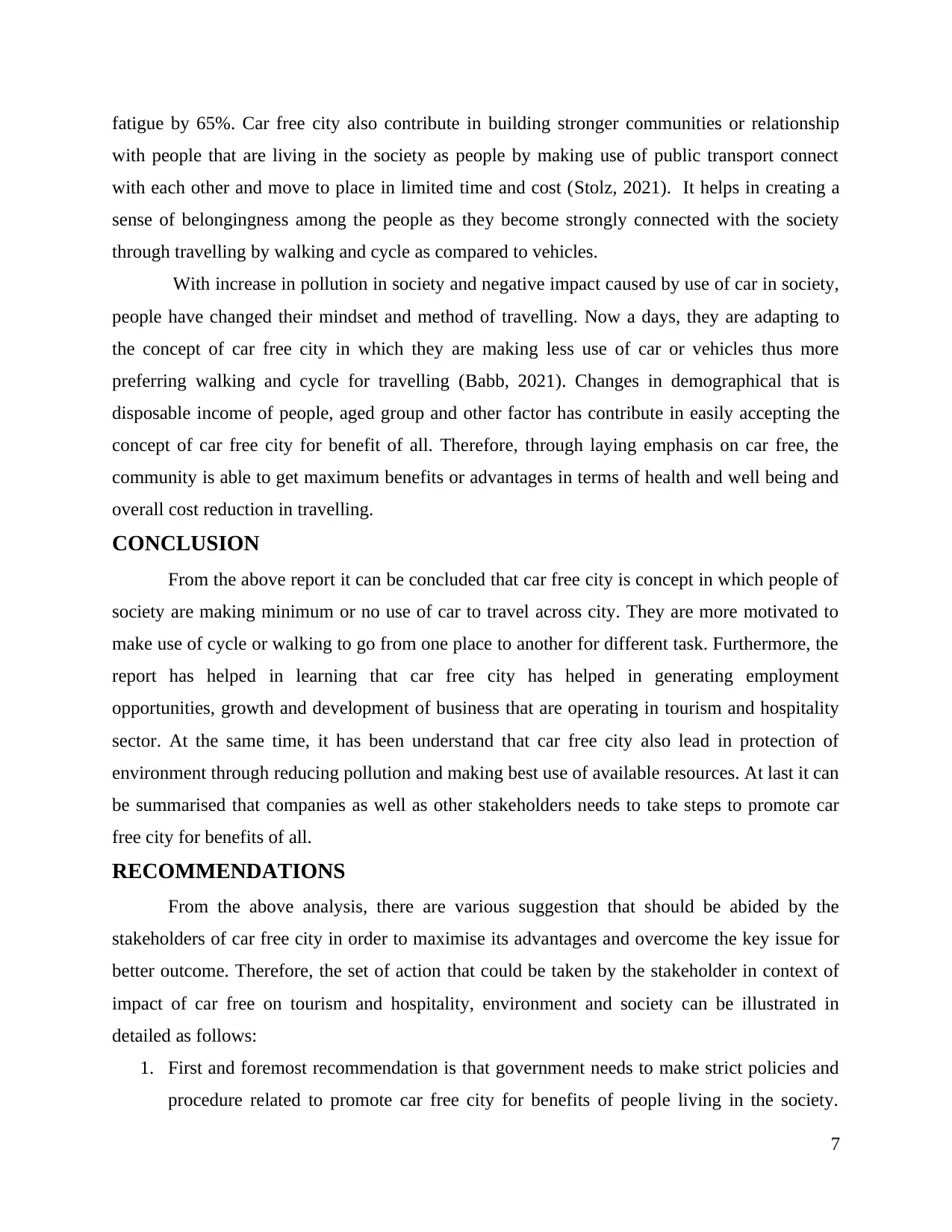
fatigue by 65%. Car free city also contribute in building stronger communities or relationship
with people that are living in the society as people by making use of public transport connect
with each other and move to place in limited time and cost (Stolz, 2021). It helps in creating a
sense of belongingness among the people as they become strongly connected with the society
through travelling by walking and cycle as compared to vehicles.
With increase in pollution in society and negative impact caused by use of car in society,
people have changed their mindset and method of travelling. Now a days, they are adapting to
the concept of car free city in which they are making less use of car or vehicles thus more
preferring walking and cycle for travelling (Babb, 2021). Changes in demographical that is
disposable income of people, aged group and other factor has contribute in easily accepting the
concept of car free city for benefit of all. Therefore, through laying emphasis on car free, the
community is able to get maximum benefits or advantages in terms of health and well being and
overall cost reduction in travelling.
CONCLUSION
From the above report it can be concluded that car free city is concept in which people of
society are making minimum or no use of car to travel across city. They are more motivated to
make use of cycle or walking to go from one place to another for different task. Furthermore, the
report has helped in learning that car free city has helped in generating employment
opportunities, growth and development of business that are operating in tourism and hospitality
sector. At the same time, it has been understand that car free city also lead in protection of
environment through reducing pollution and making best use of available resources. At last it can
be summarised that companies as well as other stakeholders needs to take steps to promote car
free city for benefits of all.
RECOMMENDATIONS
From the above analysis, there are various suggestion that should be abided by the
stakeholders of car free city in order to maximise its advantages and overcome the key issue for
better outcome. Therefore, the set of action that could be taken by the stakeholder in context of
impact of car free on tourism and hospitality, environment and society can be illustrated in
detailed as follows:
1. First and foremost recommendation is that government needs to make strict policies and
procedure related to promote car free city for benefits of people living in the society.
7
with people that are living in the society as people by making use of public transport connect
with each other and move to place in limited time and cost (Stolz, 2021). It helps in creating a
sense of belongingness among the people as they become strongly connected with the society
through travelling by walking and cycle as compared to vehicles.
With increase in pollution in society and negative impact caused by use of car in society,
people have changed their mindset and method of travelling. Now a days, they are adapting to
the concept of car free city in which they are making less use of car or vehicles thus more
preferring walking and cycle for travelling (Babb, 2021). Changes in demographical that is
disposable income of people, aged group and other factor has contribute in easily accepting the
concept of car free city for benefit of all. Therefore, through laying emphasis on car free, the
community is able to get maximum benefits or advantages in terms of health and well being and
overall cost reduction in travelling.
CONCLUSION
From the above report it can be concluded that car free city is concept in which people of
society are making minimum or no use of car to travel across city. They are more motivated to
make use of cycle or walking to go from one place to another for different task. Furthermore, the
report has helped in learning that car free city has helped in generating employment
opportunities, growth and development of business that are operating in tourism and hospitality
sector. At the same time, it has been understand that car free city also lead in protection of
environment through reducing pollution and making best use of available resources. At last it can
be summarised that companies as well as other stakeholders needs to take steps to promote car
free city for benefits of all.
RECOMMENDATIONS
From the above analysis, there are various suggestion that should be abided by the
stakeholders of car free city in order to maximise its advantages and overcome the key issue for
better outcome. Therefore, the set of action that could be taken by the stakeholder in context of
impact of car free on tourism and hospitality, environment and society can be illustrated in
detailed as follows:
1. First and foremost recommendation is that government needs to make strict policies and
procedure related to promote car free city for benefits of people living in the society.
7
Paraphrase This Document
Need a fresh take? Get an instant paraphrase of this document with our AI Paraphraser

Likewise, through making policies that people have to make less or minimum use of car
thus either makes use of public transport, walking and cycling to travel (Whitelegg,
2020). Therefore, through policy it would enforce people to accept the concept of car free
so that pollution in the environment can be reduced to maximum extend.
2. Secondly, it can be suggested that organisation performing their function in tourism and
hospitality sector also needs to invest their fund in making people aware about the car
free city, the way it can be promoted and its overall benefits. So that they can be
motivated to encourage to take active part in promoting car free city for protection of
environment and conservation of limited resources for longer time frame.
3. Thirdly, from the above analysis it can be recommended that people in the society them
self need to take steps to promote car free city through avoiding making use of car for
going to office and other place for their respective work. For short distance, people
should make use of cycle or either walking and when it is long distance then they needs
to prefer public transport (Kim, 2017). As it will contribute in protecting environment,
saving resources, reducing carbon footprint and ensuring good health and well being of
people living in society.
Therefore it can be stated that car free city is the concept that need to be adapted by each and
every stakeholder in the society for gaining its maximum benefits.
8
thus either makes use of public transport, walking and cycling to travel (Whitelegg,
2020). Therefore, through policy it would enforce people to accept the concept of car free
so that pollution in the environment can be reduced to maximum extend.
2. Secondly, it can be suggested that organisation performing their function in tourism and
hospitality sector also needs to invest their fund in making people aware about the car
free city, the way it can be promoted and its overall benefits. So that they can be
motivated to encourage to take active part in promoting car free city for protection of
environment and conservation of limited resources for longer time frame.
3. Thirdly, from the above analysis it can be recommended that people in the society them
self need to take steps to promote car free city through avoiding making use of car for
going to office and other place for their respective work. For short distance, people
should make use of cycle or either walking and when it is long distance then they needs
to prefer public transport (Kim, 2017). As it will contribute in protecting environment,
saving resources, reducing carbon footprint and ensuring good health and well being of
people living in society.
Therefore it can be stated that car free city is the concept that need to be adapted by each and
every stakeholder in the society for gaining its maximum benefits.
8
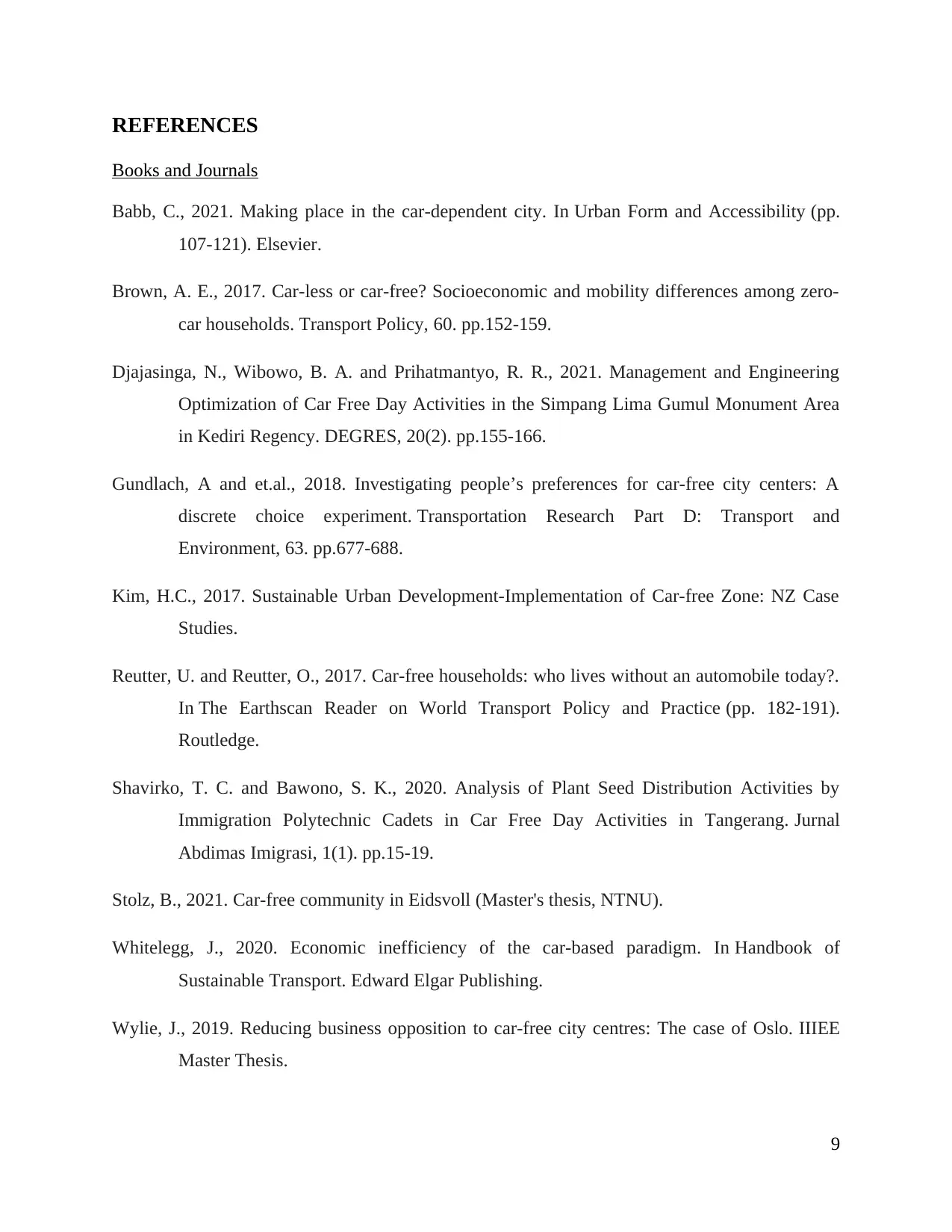
REFERENCES
Books and Journals
Babb, C., 2021. Making place in the car-dependent city. In Urban Form and Accessibility (pp.
107-121). Elsevier.
Brown, A. E., 2017. Car-less or car-free? Socioeconomic and mobility differences among zero-
car households. Transport Policy, 60. pp.152-159.
Djajasinga, N., Wibowo, B. A. and Prihatmantyo, R. R., 2021. Management and Engineering
Optimization of Car Free Day Activities in the Simpang Lima Gumul Monument Area
in Kediri Regency. DEGRES, 20(2). pp.155-166.
Gundlach, A and et.al., 2018. Investigating people’s preferences for car-free city centers: A
discrete choice experiment. Transportation Research Part D: Transport and
Environment, 63. pp.677-688.
Kim, H.C., 2017. Sustainable Urban Development-Implementation of Car-free Zone: NZ Case
Studies.
Reutter, U. and Reutter, O., 2017. Car-free households: who lives without an automobile today?.
In The Earthscan Reader on World Transport Policy and Practice (pp. 182-191).
Routledge.
Shavirko, T. C. and Bawono, S. K., 2020. Analysis of Plant Seed Distribution Activities by
Immigration Polytechnic Cadets in Car Free Day Activities in Tangerang. Jurnal
Abdimas Imigrasi, 1(1). pp.15-19.
Stolz, B., 2021. Car-free community in Eidsvoll (Master's thesis, NTNU).
Whitelegg, J., 2020. Economic inefficiency of the car-based paradigm. In Handbook of
Sustainable Transport. Edward Elgar Publishing.
Wylie, J., 2019. Reducing business opposition to car-free city centres: The case of Oslo. IIIEE
Master Thesis.
9
Books and Journals
Babb, C., 2021. Making place in the car-dependent city. In Urban Form and Accessibility (pp.
107-121). Elsevier.
Brown, A. E., 2017. Car-less or car-free? Socioeconomic and mobility differences among zero-
car households. Transport Policy, 60. pp.152-159.
Djajasinga, N., Wibowo, B. A. and Prihatmantyo, R. R., 2021. Management and Engineering
Optimization of Car Free Day Activities in the Simpang Lima Gumul Monument Area
in Kediri Regency. DEGRES, 20(2). pp.155-166.
Gundlach, A and et.al., 2018. Investigating people’s preferences for car-free city centers: A
discrete choice experiment. Transportation Research Part D: Transport and
Environment, 63. pp.677-688.
Kim, H.C., 2017. Sustainable Urban Development-Implementation of Car-free Zone: NZ Case
Studies.
Reutter, U. and Reutter, O., 2017. Car-free households: who lives without an automobile today?.
In The Earthscan Reader on World Transport Policy and Practice (pp. 182-191).
Routledge.
Shavirko, T. C. and Bawono, S. K., 2020. Analysis of Plant Seed Distribution Activities by
Immigration Polytechnic Cadets in Car Free Day Activities in Tangerang. Jurnal
Abdimas Imigrasi, 1(1). pp.15-19.
Stolz, B., 2021. Car-free community in Eidsvoll (Master's thesis, NTNU).
Whitelegg, J., 2020. Economic inefficiency of the car-based paradigm. In Handbook of
Sustainable Transport. Edward Elgar Publishing.
Wylie, J., 2019. Reducing business opposition to car-free city centres: The case of Oslo. IIIEE
Master Thesis.
9
⊘ This is a preview!⊘
Do you want full access?
Subscribe today to unlock all pages.

Trusted by 1+ million students worldwide

10
Paraphrase This Document
Need a fresh take? Get an instant paraphrase of this document with our AI Paraphraser

11

12
⊘ This is a preview!⊘
Do you want full access?
Subscribe today to unlock all pages.

Trusted by 1+ million students worldwide
1 out of 12
Related Documents
Your All-in-One AI-Powered Toolkit for Academic Success.
+13062052269
info@desklib.com
Available 24*7 on WhatsApp / Email
![[object Object]](/_next/static/media/star-bottom.7253800d.svg)
Unlock your academic potential
Copyright © 2020–2025 A2Z Services. All Rights Reserved. Developed and managed by ZUCOL.


